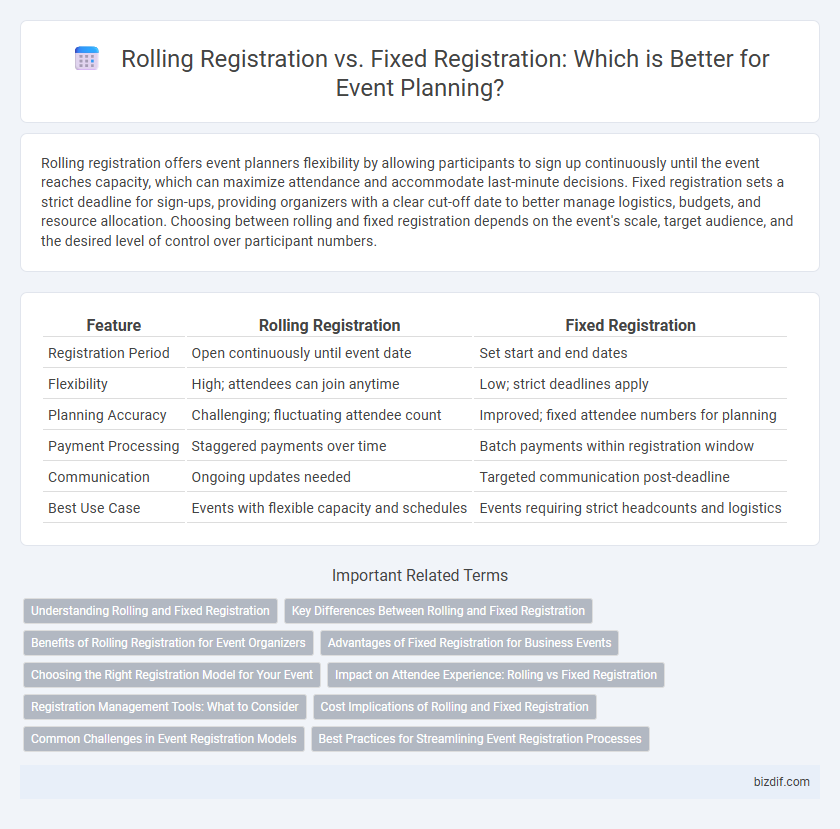Rolling registration offers event planners flexibility by allowing participants to sign up continuously until the event reaches capacity, which can maximize attendance and accommodate last-minute decisions. Fixed registration sets a strict deadline for sign-ups, providing organizers with a clear cut-off date to better manage logistics, budgets, and resource allocation. Choosing between rolling and fixed registration depends on the event's scale, target audience, and the desired level of control over participant numbers.
Table of Comparison
| Feature | Rolling Registration | Fixed Registration |
|---|---|---|
| Registration Period | Open continuously until event date | Set start and end dates |
| Flexibility | High; attendees can join anytime | Low; strict deadlines apply |
| Planning Accuracy | Challenging; fluctuating attendee count | Improved; fixed attendee numbers for planning |
| Payment Processing | Staggered payments over time | Batch payments within registration window |
| Communication | Ongoing updates needed | Targeted communication post-deadline |
| Best Use Case | Events with flexible capacity and schedules | Events requiring strict headcounts and logistics |
Understanding Rolling and Fixed Registration
Rolling registration allows event organizers to accept participant sign-ups continuously until capacity is reached, providing flexibility and maximizing attendance. Fixed registration sets a strict deadline for sign-ups, enabling precise planning and resource allocation based on a known number of attendees. Understanding the differences between rolling and fixed registration helps optimize event logistics, budget forecasting, and marketing strategies.
Key Differences Between Rolling and Fixed Registration
Rolling registration allows participants to sign up continuously until the event reaches capacity, providing flexibility and attracting late decision-makers. Fixed registration opens and closes on set dates, enabling organizers to finalize logistics and predict attendance with greater accuracy. The choice impacts event management, attendee commitment, and marketing strategies.
Benefits of Rolling Registration for Event Organizers
Rolling registration offers event organizers increased flexibility in managing attendee numbers, enabling ongoing monitoring and adjustment to marketing strategies based on real-time sign-up data. This approach improves cash flow by spreading registration fees over a longer period and reduces last-minute cancellations through continuous engagement. Additionally, rolling registration enhances the ability to forecast attendance trends and optimize resource allocation, resulting in a more efficient event planning process.
Advantages of Fixed Registration for Business Events
Fixed registration offers predictable attendance numbers, enabling precise budgeting and resource allocation for business events. It streamlines event logistics by setting clear deadlines, reducing last-minute cancellations and no-shows. This method enhances marketing strategies by creating urgency and encouraging early commitment from participants.
Choosing the Right Registration Model for Your Event
Choosing the right registration model for your event depends on factors like event size, attendee demographics, and timeline flexibility. Rolling registration allows continuous sign-ups, ideal for long-term or evolving events with variable attendance, while fixed registration sets a clear deadline, creating urgency and helping organizers manage capacity and logistics more effectively. Analyzing your event's goals, budget, and attendee behavior ensures optimal registration strategy, improving engagement and operational efficiency.
Impact on Attendee Experience: Rolling vs Fixed Registration
Rolling registration enhances attendee flexibility by allowing participants to sign up anytime before the event, leading to increased satisfaction and higher overall attendance rates. Fixed registration sets a strict deadline, offering a structured planning timeline but potentially causing stress for attendees who miss the cutoff. This contrast significantly impacts attendee experience, with rolling registration fostering inclusivity and fixed registration ensuring logistical certainty.
Registration Management Tools: What to Consider
Choosing between rolling registration and fixed registration requires event planners to evaluate registration management tools that support real-time updates, customizable deadlines, and efficient attendee tracking. Tools with automation features streamline communication and reduce no-shows by sending timely reminders based on dynamic registration periods. Integration capabilities with payment gateways and CRM systems enhance data accuracy and improve overall event coordination.
Cost Implications of Rolling and Fixed Registration
Rolling registration often increases administrative costs due to the continuous need for processing and resource allocation as participants register over time. Fixed registration allows for more predictable budgeting and resource management, as the event organizer can plan based on a definite number of attendees by the registration deadline. Cost implications also include potential revenue fluctuations, where rolling registration may generate steady income but complicates forecasting, unlike fixed registration's stable but upfront payment model.
Common Challenges in Event Registration Models
Rolling registration often leads to unpredictable attendee numbers, complicating venue and resource planning, while fixed registration requires strict deadlines that may deter late registrants and limit overall participation. Both models struggle with balancing flexibility and commitment, causing challenges in forecasting budget and staffing needs accurately. Inefficient registration tracking systems further exacerbate issues by delaying data consolidation and timely decision-making.
Best Practices for Streamlining Event Registration Processes
Rolling registration allows attendees to sign up anytime before the event, increasing flexibility and maximizing participation, while fixed registration sets a strict deadline to encourage early commitment and simplify planning. Best practices include clearly communicating registration deadlines, offering automated reminders, and integrating user-friendly online platforms to reduce administrative tasks. Utilizing data analytics to track registration trends helps optimize marketing efforts and ensures resource allocation aligns with attendee numbers.
Rolling registration vs Fixed registration Infographic

 bizdif.com
bizdif.com